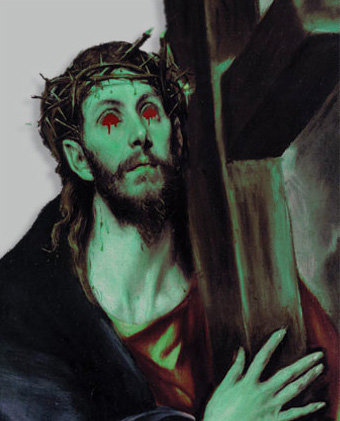 Today I came across an essay and interview that appeared last year in Religion Dispatches by Jason VonWachenfeldt that touched on a controversy between the Vatican and systematic theologian Roger Haight. I’m not sure of the present state of the controversy, if there is one, but a year ago the Vatican had concerns about some of the views of Haight that surfaced as a result of a book he published. In order to explore the subject, VonWachenfeldt interviewed Jeremy Kirk, a student of Haight’s at Union Theological Seminary who did his MA on the professor’s Christology. Among Haight’s controversial views from the perspective of the Vatican is his perspective on the resurrection of Jesus. When asked to describe Haight’s views on this topic Kirk said:
Today I came across an essay and interview that appeared last year in Religion Dispatches by Jason VonWachenfeldt that touched on a controversy between the Vatican and systematic theologian Roger Haight. I’m not sure of the present state of the controversy, if there is one, but a year ago the Vatican had concerns about some of the views of Haight that surfaced as a result of a book he published. In order to explore the subject, VonWachenfeldt interviewed Jeremy Kirk, a student of Haight’s at Union Theological Seminary who did his MA on the professor’s Christology. Among Haight’s controversial views from the perspective of the Vatican is his perspective on the resurrection of Jesus. When asked to describe Haight’s views on this topic Kirk said:
Following from this, Haight would affirm that the resurrection was not an historical event that happened physically and empirically in the space-time continuum. When Christians bury a loved one, they put the body in the ground with the faith/hope that the person is resurrected in a way that does not deny the historicity of the physical burial. Haight would state that Jesus’ body did not go anywhere; it is not the resuscitation of a corpse. There was no zombie Jesus.
This is the first time that I have seen reference to “zombie Jesus” in an academic context. It is quite extensive as a pop-culture phenomenon, as any Google search will confirm, surfacing on t-shirts, Internet images, as a character at some of the zombie walks that have taken place internationally, a Facebook page, an Uncyclopedia entry, a website devoted to Zombie Jesus Day, and even as a comedy horror film.
A few thoughts come to mind as a result of this topic.
First, I believe that one of the issues lurking beneath the concept of “zombie Jesus” are postmodern concepts of the body. Without an awareness of Christendom’s teachings on the resurrection body as a transformed and immortal physical body, it is understandable how one could read the resurrection of Jesus in zombie-like fashion. The Zombie Jesus Day website argues, “Everything that rises from the dead is a zombie. Easter is touted as the death and resurrection of Jesus Christ. So let’s call a spade a spade, eat lots of chocolate, and celebrate Zombie Jesus Day.” In addition, the Zombie Jesus on Facebook website goes further in connecting New Testament texts to the concept, arguing that Jesus came back from the dead in keeping with Acts 2:24, and that Jesus “encourages zombie like behavior,” referencing John 6:53: “Jesus said to them, ‘I tell you the truth, unless you eat the flesh of the Son of Man and drink his blood, you have no life in you.'” A study of postmodern conceptions of the body might shed light on the “zombie Jesus” phenomenon in its satire and parody of Christianity as well as other meanings, perhaps even hint at a critique of the frequent Christian emphasis on the soul/spirit to the neglect of the physical body and material creation, and help provide another face of understanding in the continued popularity of zombie films.
Second, Haight and other theologians miss an opportunity to engage contemporary concerns with a practical theology when they do not explore the zombie Jesus concept in popular culture. This is especially surprising in Haight’s case since the essay in RD states that “Haight’s project was intended for a current intellectual context” that addresses “the postmodern critiques of Christianity.” Rather than simply invoking the term “zombie Jesus,” Haight and other theologians might consider exploring the concept in more depth, unpacking its various meanings, engaging in self-critical theological reflection where appropriate, and then engaging those who enjoy the figure of “zombie Jesus.”
Third, Haight might reconsider the dichotomy he makes between those Christians who bury lost loved ones in faith/hope and the possibility of a bodily resurrection of Jesus as a “historical event that happened physically and empirically in the space-time continuum.” It is possible that the resurrection was “a transcendent reality that is a matter of faith and hope” as well as a historical event. Scholars like N.T. Wright have argued in this way, and it is a view at least worth considering before rejecting it outright in relation to a postmodern critique of Christianity. (For an interesting read that looks at very different interpretations of Jesus, including the resurrection, by two good scholars see The Meaning of Jesus: Two Visions, 2nd ed. (HarperOne, 2007) by Marcus T. Borg and N. T. Wright.)
This case provides yet another example of the connection between horror and religion, in particular between the zombie and theology, indicating that even zombies can function as suitable objects for theological reflection for those daring theologians willing to explore this territory.
Related posts:
“Philly Zombie Crawl and ‘Zombie Jesus'”
“Reflections on a Zombie Supper”
“Religion Dispatches: Toward a Zombie Theology”





There are no responses yet